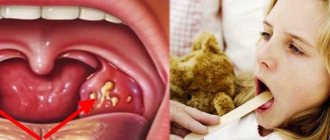Increased body temperature, painful sensations in the throat, weakness, headache - people usually attribute these symptoms in the spring-winter period to a common cold. However, often such signs indicate the development of a dangerous infectious disease, which doctors call purulent tonsillitis. The disease is manifested by severe inflammation of the tonsils (glands), located in the nasopharynx. The infection primarily affects the parenchyma and lymphoid tissue lining the tonsils. The disease is dangerous due to severe complications that develop when symptoms are ignored and there is no proper treatment.
If you suspect that you have a sore throat and need to consult a doctor, call +7 (499) 653-58-25 - we will definitely help you. Reception is carried out both in the clinic and with a visit to the patient’s home. To register online, fill out the form on the website.
Causes
Inflammation of the palatine tonsils is provoked by infections transmitted by airborne droplets. Less commonly, infection occurs through contact and household contact (through shared dishes, towels, bed linen). The most common causative agent of purulent sore throat is hemolytic streptococcus. However, if a person’s immune system works normally, bacteria of this group die immediately after entering the body. The development of pathology is facilitated by weakened immunity and provoking factors.
Indirect causes of purulent sore throat include:
- severe hypothermia;
- chronic diseases of the upper respiratory tract;
- oral infections;
- alcoholism and smoking history;
- stress, overwork, strong emotional tension;
- living in areas with difficult environmental conditions;
- deficiency of vitamins and nutrients;
- mechanical damage to the tonsils (trauma, surgery).
The disease is diagnosed with equal frequency in adults and children.
Treatment of lacunar tonsillitis
Drug therapy is prescribed only after examination by an otolaryngologist, laryngoscopy, and blood and smear tests. The examination will show the nature of the plaque - lacunar tonsillitis is characterized by a fluffy filmy coating.
Basically, the treatment regimen does not differ from ordinary tonsillitis. It includes:
- Taking medications. This necessarily includes antibiotics of the penicillin group and macrolides. They are the ones who fight the main cause of the disease – streptococcus. Antipyretics, antihistamines to relieve swelling of the tonsils, and eubiotics to restore intestinal flora after taking antibiotics are also prescribed.
- Gargling.
- Irrigation of tonsils with antiseptics.
- Vitamin therapy.
- Inhalations. Cleansing the upper respiratory tract with steam reduces swelling, inflammation and bacterial growth. Inhalation of alkaline water, saline, antiseptic, and homeopathic medicines has a beneficial effect. It is convenient to use a nebulizer as a nebulizer.
The duration of treatment is at least 7 days and no more than 14 days.
After the inflammation has decreased and pus has ceased to be produced, physiotherapy is prescribed. Infrared irradiation, magnetic therapy, and phonophoresis are effective. These procedures increase local immunity, accelerate tissue regeneration, and shorten the recovery period.
In case of inflammation of lacunae, nutrition is an important factor. Since swallowing is difficult, you need to eat liquid food. You should exclude all foods that scratch and irritate a sore throat. It is recommended to drink up to three liters of fluid per day to reduce signs of intoxication.
Incubation period
The period from the moment the pathogen enters the body until the appearance of the first characteristic symptoms can range from 2 to 6 days. During the first few days, the sick person is still unaware of his condition, becoming a source of infection for others. During the incubation period, the infection is actively transmitted by airborne droplets (through coughing, sneezing, kissing, talking). The onset of the disease is manifested by a feeling of chills, increased body temperature, weakness and headache. The sooner the patient sees a doctor, the easier the treatment is.
Is it contagious and how is it transmitted?
Because Lacunar tonsillitis is of an infectious nature in 99% of all cases (not counting unique autoimmune reactions); naturally, it is contagious. A person becomes contagious during the incubation period (1-2 days before the first symptoms appear) and remains so until complete recovery.
Methods of infection:
- airborne - if you just stay near the patient for enough time;
- through shared utensils;
- through food (therefore you cannot finish eating or drinking anything while sick).
In particular, contact of the patient with children and people already suffering from something (for example, acute respiratory infections) is unacceptable.
Symptoms of purulent sore throat
In most patients, the first signs of purulent tonsillitis appear 2-3 days after the pathogen enters the body. When the patient's immunity is weakened, the clinical picture is most pronounced. In adult patients, the following symptoms are observed:
- the appearance of noticeable white or yellowish spots of pus on the tonsils;
- high body temperature (in the range of 39-40 ° C);
- intense pain in the throat that increases during swallowing;
- significant enlargement of the lymph nodes located under the lower jaw;
- easily removable whitish coating on the tongue;
- severe headaches;
- feeling weak and overwhelmed;
- loss of appetite;
- aching joints.
In adults, with timely treatment, the acute stage of the disease rarely lasts longer than a week. If the patient does not seek help from specialists, there is a risk of complications.
Expert opinion
As an ENT specialist, I must note that lacunar tonsillitis is a rather dangerous disease in pediatric practice. Against the background of severe intoxication syndrome, the child’s condition is often difficult to stabilize. Convulsions at the peak of fever are especially dangerous. Children under 3 years of age must be examined by a doctor if characteristic symptoms of the disease are detected. This group of patients is prone to a sharp deterioration in health with the development of complications. Immediate medical attention is required.
Stages of disease development
The disease progresses rapidly. This is especially true in children and adults with a weakened immune response. Symptoms depend on the current state of the body, age, concomitant diseases and the stage of infectious tissue damage.
Signs of the development of the disease at different stages from the moment of infection:
- 2-3 days.
This stage is characterized by the maximum severity of the symptomatic picture. The patient's tonsils increase significantly in size and white or yellowish ulcers appear on their surface. The inflammatory process covers the entire surface of the tonsils. The patient notes deterioration in health, weakness, loss of appetite and signs of fever, including an increase in body temperature to 39-40 ° C. The patient also experiences excruciating pain in the throat, which gets worse when swallowing. - Day 4
The ulcers that form on the tonsils begin to spontaneously open, releasing the contents (pus). In their place, lacunae are formed - characteristic depressions. If at this stage the patient follows the doctor’s recommendations, the lacunae quickly close. - 5-6 day
. At this stage, patients feel a noticeable improvement in their condition - body temperature normalizes, headaches go away, strength and appetite are restored. - 7-10 day
. The last pathological sign – sore throat – recedes. The size of the lymph nodes located under the lower jaw also decreases. The patient ceases to feel pain and discomfort in this area.
Competent and timely therapy allows you to avoid serious complications.
Questions
- Which doctor treats lacunar tonsillitis in children?
An otolaryngologist is involved in identifying and treating lacunar tonsillitis in children. - How to independently treat lacunar tonsillitis in children?
Self-medication and the use of traditional medicine in cases of lacunar tonsillitis lead to a deterioration in the child’s well-being. The disease is characterized by rapid progression. Without taking antibacterial agents and examining a doctor, it is very difficult to change anything. This is especially true for children under 3 years of age, when the general condition can change for the worse before our eyes. Therefore, it is always worth consulting with an ENT specialist first. - Does piercing help with sore throat?
Stabbing is a set of measures aimed at strengthening a person’s physical health. It should be used with caution in children. It is known that stabbing enhances the effectiveness of the body's immune defense. Therefore, it is considered a factor that reduces the risk of developing angina. However, if the disease develops, hardening is contraindicated. - Is it possible to smear the throat with iodine for lacunar tonsillitis?
Traditional alcohol solution of iodine is not suitable for the treatment of tonsillitis. It irritates the mucous membrane of the oropharynx and can even cause a local chemical burn. It is better to use Lugol's solution or other analogues of aqueous iodine solutions. Such drugs are a good addition to antibiotic therapy for lacunar angina, but cannot ensure recovery (in combination, antimicrobial drugs are required).
Forms of the disease
The form of purulent tonsillitis depends on many associated factors and conditions. The most common three forms of development are follicular, lacunar and ulcerative-membranous (necrotic). Each type is characterized by characteristics of the course, specific lesions of the tonsil tissue and varying duration.
Follicular
Follicular tonsillitis is manifested by pinpoint purulent lesions of the parenchyma of lymphoid tissue and follicles of the tonsils. The disease in 85% of cases is caused by group A streptococci. The remaining cases of infection are associated with staphylococcal infection, Haemophilus influenzae, pneumococcus, and adenovirus. This form of pathology is accompanied by a rapid increase in the symptom complex, severe hyperthermia, sweating, loss of sleep and appetite. Intense pain in the throat can radiate to the ear.
Lacunarnaya
This type of disease causes severe inflammatory damage to the tissues of the peripharyngeal ring. The opening of abscesses is accompanied by the formation of specific perforations on the surface of the tonsils - lacunae. The acute phase of the disease is manifested by an increase in the size of the tonsils, up to difficulty breathing. Along with other symptoms, a characteristic sign of the lacunar type of pathology is bad breath. Sometimes doctors note a noticeable change in voice and diction problems. Inadequate therapy can lead to the development of a paratonsillar or retropharyngeal abscess.
Necrotic
Necrotizing ulcerative tonsillitis is rare (about 5-6% of cases). The main cause of the development of this type of disease is fusospirochetous infection. The rapid development of the infectious-inflammatory process causes the formation of histological changes in the tissues of the palatine tonsils. Violations of vascular permeability, associated with the active production of histamine and cytokines, lead to hypertrophy and sometimes tissue necrosis. The first sign of the disease is the feeling of a “lump in the throat.” Later, a sharp, unpleasant putrid odor appears from the mouth and salivation increases.
Etiology and pathogenesis
Among the various possible microbial pathogens of sore throat (cocci, bacilli, viruses, spirochetes, fungi, etc.), in most cases the main etiological role belongs to group A b-hemolytic streptococcus (GABHS). This pathogen, according to a number of authors, is detected in sore throat in more than 80%, according to other sources - in 50–70% of cases. Much less frequently, acute tonsillitis is caused by group C and G streptococci, Arcanobacterium haemolyticum, Neisseria gonorrhoeae, Corynebacterium diphtheria (diphtheria), anaerobes and spirochetes (Simanovsky-Plaut-Vincent angina), and extremely rarely by mycoplasma and chlamydia. The cause of acute viral tonsillitis can be adenovirus, rhinovirus, coronavirus, influenza and parainfluenza viruses, Epstein-Barr virus, Coxsackie A virus and others. Penetration of an exogenous pathogen into the mucous membrane of the tonsils can occur through airborne droplets and alimentary routes, as well as through direct contact. In the occurrence of an endogenous pathogen, great importance is attached to chronic tonsillitis. As noted by B.S. Preob¬ra¬zhensky (1954), the frequency of sore throats in chronic tonsillitis is explained by the fact that in this disease there are usually up to 75% of cases of carriage of GABHS, vegetating in the crypts of the palatine tonsils.
In the pathogenesis of tonsillitis, a certain role can be played by a decrease in the body’s overall reactivity to cold, sharp seasonal fluctuations in environmental conditions (temperature, humidity, nutrition, intake of vitamins, etc.), trauma to the tonsils, constitutional predisposition to tonsillitis (for example, in children with lymphatic – hyperplastic constitution), the state of the central and autonomic nervous system. Factors predisposing to angina are chronic inflammatory processes in the mouth, nose and paranasal sinuses. The development of sore throat occurs according to the type of allergic-hyperergic reaction, which is a prerequisite for complications such as rheumatism, acute diffuse nephritis and other diseases of an infectious-allergic nature and associated with the GABHS antigen.
Diagnosis and treatment
To make a diagnosis and determine treatment approaches, you need to consult an otolaryngologist. Diagnostics is carried out according to the following algorithm:
- collection of medical history and complaints;
- examination of the pharynx using special lighting (pharyngoscopy);
- general and biochemical blood test;
- bacteriological examination of a smear with the preparation of an antibiogram.
How to treat a purulent sore throat is determined by an ENT specialist. In severe cases, hospitalization is required. General medical recommendations include bed rest, drinking plenty of fluids, taking vitamins and restorative medications.
Specific treatment of the disease is a complex of procedures and medications:
- Drug treatment of the oral cavity.
Complex therapy necessarily includes gargling with antiseptic solutions. For this purpose, solutions of furatsilin, manganese, hydrogen peroxide, sea salt, and natural herbal decoctions (chamomile, calendula) are used. This procedure is aimed at removing pathogenic microorganisms from the throat and mouth. - Taking systemic antibacterial drugs.
A full course of antibiotic therapy allows you to get rid of pathogenic flora. Antibiotics and their dosages can only be determined and prescribed by a doctor. The most commonly used drugs are from the groups of penicillins, macrolides and cephalosporins. - Symptomatic therapy.
To alleviate the patient’s condition during the acute stage, the specialist prescribes symptomatic treatment in the form of antipyretics, antihistamines and anti-inflammatory drugs. Sometimes it is recommended to undergo physiotherapeutic procedures during the recovery period.
Correctly selected treatment helps to avoid serious consequences and ensures healing of the affected tissue areas without visible defects.
What to gargle with?
Local treatment of tonsillitis is no less effective than taking general medications. Gargling with solutions (furacilin, eludril, soda + iodine + salt), and decoctions (sage, calendula) helps eliminate pain and relieve inflammation of the tonsils.
You should gargle at least once every 2 hours; this process cleanses the pharyngeal mucosa from waste products of pathogenic microorganisms, washes away pus from its surface, and fights inflammation.
You can also watch a video of the program “Live Healthy” about the treatment of sore throat.
Purulent sore throat in children
If the disease develops in a child, in addition to the main symptoms, digestive disorders often appear - diarrhea, nausea, vomiting. Children may complain of abdominal pain caused by intestinal spasms. The follicular type of pathology is especially difficult for children aged 5-10 years, causing inflammation of the meninges. Young patients often experience fainting, dry cough and complaints of a feeling of a foreign object in the throat.
If parents ignore the symptoms, the pathology becomes chronic. Pediatricians call this condition chronic tonsillitis, exacerbations of which occur 2-3 times a year.
Sources
- Chronic tonsillitis: different views on an old problem. / G.R. Kaspranskaya, A. S. Lopatin. // Medical advice. - 2013. - No. 5-6. — P. 69-71.
- Immunological aspects of chronic tonsillitis associated with Ebstein-Barr virus infection / A.S. Krasnitskaya, N.A. Borovskaya. // Fundamental research. – 2012. – No. 4-2. – pp. 299-305.
- Belov, V.A. Modern methods of microbiological diagnostics for exacerbation of chronic and acute forms of tonsillitis in children. / V.A. Belov. // Issues of modern pediatrics. - 2012. - T. 11, No. 2. - P. 128-131.
Complications and consequences
The advanced form of the disease leads to inflammatory damage to other organs, including the heart, kidneys, and joints. The most dangerous complications include:
- mediastinitis
– inflammation of the mediastinal tissue; - chronic bronchitis
- inflammatory damage to the bronchi; - sepsis –
spread of infection through the bloodstream; - arthritis -
inflammation of the joints; - glomerulonephritis is
a dangerous kidney disease; - purulent meningitis -
damage to the meninges; - peripharyngeal abscesses
- suppuration of the lymph nodes and tissue of the peripharyngeal space.
Timely access to a medical facility allows you to avoid negative health consequences.
Complications after a sore throat: where to expect a blow?
First of all, the ENT organs closest to the source of inflammation come under attack, especially vulnerable after suffering from a sore throat. Therefore, the recovery period, which takes place under the supervision of a specialist, will eliminate the development of a number of dangerous diseases:
- lymphadenitis (inflammation of the lymph nodes) can accompany any form of sore throat. In case of suppuration of the lymph nodes, immediate surgical intervention is required;
- Laryngeal edema is a consequence of excessive swelling of the tonsils and can spread further to the vocal cords. Rapidly developing suffocation poses a serious threat to the patient's life;
- Mediastinitis can occur as a result of suppuration of the posterior pharyngeal wall. The inflammatory process affects the deep cervical regions, right up to the mediastinum.
Chronic tonsillitis occurs after severe or frequent recurrences of tonsillitis. Overgrowth of tonsil tissue is treated with medication, although in some cases surgery is required;
Therefore, it is so important to entrust the treatment of sore throat to a qualified doctor who will determine the form of the disease and prescribe antibiotics that are mandatory in the treatment of sore throat.
The course of therapy should be carried out under the supervision of a specialist who can quickly and correctly respond to any changes in the body and prevent the development of irreversible consequences.
During pregnancy, sore throat is especially dangerous. Intoxication of the mother’s body can harm the baby, and in the early stages (up to 12 weeks) there is often a threat of miscarriage.
Prevention
By paying attention to preventive measures, you can reduce the risk of developing the disease. Effective prevention includes:
- avoiding hypothermia (wearing warm clothes, monitoring microclimatic indicators in the room);
- regular preventative visits to the dentist to identify the early stages of caries and stomatitis;
- giving up bad habits (smoking, drinking alcohol);
- moderate physical activity, regular walks in the fresh air;
- normalization of diet, sleep and wakefulness;
- compliance with hygiene standards and requirements, maintaining cleanliness in the home and workplace;
- limiting contacts with unfamiliar people during periods of unfavorable epidemiological conditions.
Strengthening the immune system based on leading a healthy lifestyle helps to avoid infection and make it easier to endure purulent sore throat.
If you have a sore throat, call us and we will definitely help you!









